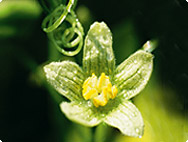A.Vogel search
When the internal search is activated, personal data such as your IP address is transmitted to our search engine Cludo. Data is thus transferred to a third country. Please click here if you want to display the internal search. You can find more information on data protection here: Privacy policy.
A.Vogel plant encyclopaedia
Bryonia cretica L. ssp. dioica
White Bryony
History

According to Pliny, the name Bryonia stems from the Greek bryo and bryéin, which mean «to grow» or «to sprout lushly» and which refer to the stalks that sprout rapidly and numerously from the root stock. Cretica derives from the Latin créticus or the Greek krétikos and indicates the plant's Cretan origin. The botanist Linné named the subspecies dioica for «two-housed», from the Greek di for «two» and oíkos for «house».
The red berried White Bryony (Bryonia cretica ss. dioica) has to be distinguished from the Black-berried or European White Bryony (Bryonia alba) that is used in medicine as well.
Bryony's drastic purgative effect was already known to the physicians of antiquity.
Botanical characteristics

The bryony's light yellow, malodorous root grows as fat as a beet and can weigh as much as 2.5 kg. The plant's rough-haired stalks grow up to 4 m long and grasp hedges and fences with spiralling, unbranched, creeping tendrils. The stemmed, short-bristled leaves pentafid or palmate beyond the middle are entire or bluntly toothed on the margins. Each leaf stands opposite a tendril.
The red bryony is dioecious (two-housed) greenish-white and grouped in long-stemmed clusters, while the somewhat smaller, light green female plants sit in tufts resembling calyces in the leaf axils. The thin-skinned, spherical, scarlet red, poisonous berries develop in the Fall. The berries of the black-berried white bryony (Bryonia alba) are black when ripe, whereas the black bryony (Tamus communis) has red berries, too.
White bryony flowers from June to July.
Habitat

The bryony is widely distributed, from Central Europe to the Sea of Japan, and is especially frequently found in Central and Southern Europe and in North Africa. It grows scattered on fences, hedges, bushes, wet woods, and winegrowing regions.
Preparation

A.Vogel/Bioforce uses a homeopathic mother tincture produced in accordance with the actual HAB. The mother tincture is made from fresh roots of Bryonia cretica L. ssp. Dioica (Jacq.) Tutin or Bryonia alba L. collected before the plant begins to bloom. The potentisation of the dilution is carried out manually.